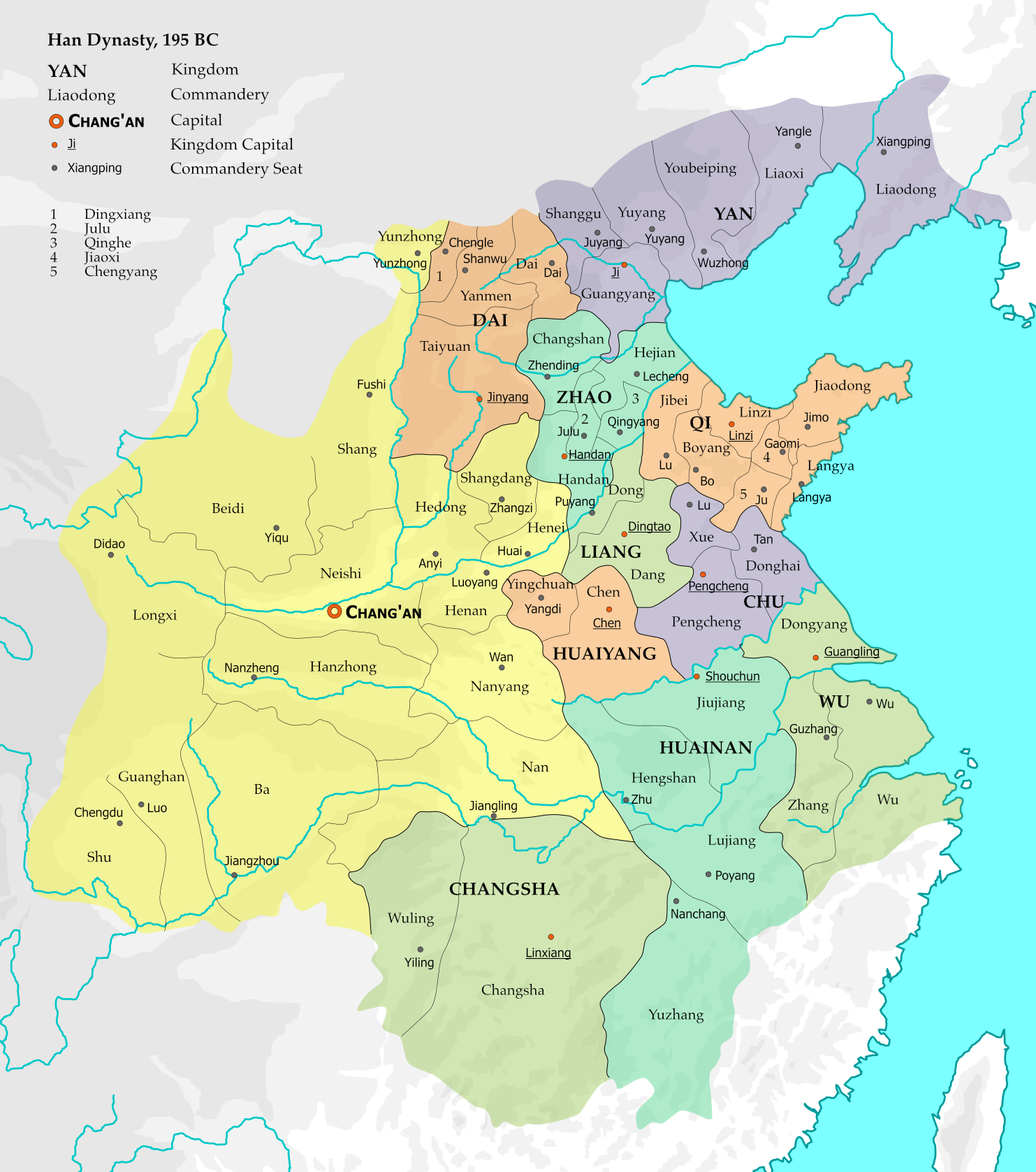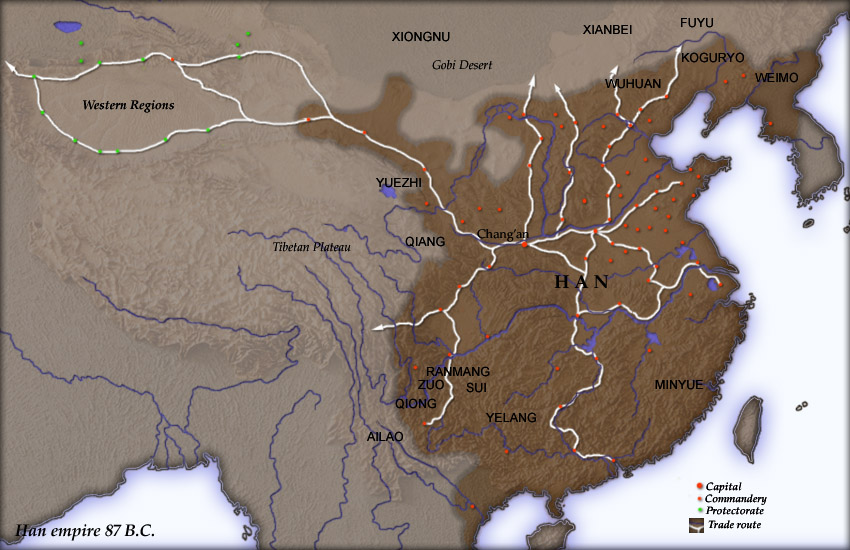|
Xianbei State
The Xianbei state or Xianbei confederation was a nomadic empire which existed in modern-day Mongolia, Inner Mongolia, northern Xinjiang, Northeast China, Gansu, Buryatia, Zabaykalsky Krai, Irkutsk Oblast, Tuva, Altai Republic and eastern Kazakhstan from 156 to 234. Like most ancient peoples known through Chinese historiography, the ethnic makeup of the Xianbei is unclear. History Origin When the Donghu "Eastern Barbarians" were defeated by Modu Chanyu around 208 BC, the Donghu splintered into the Xianbei and Wuhuan. According to the ''Book of the Later Han'', “the language and culture of the Xianbei are the same as the Wuhuan”. The first significant contact the Xianbei had with the Han dynasty was in 41 and 45 when they joined the Wuhuan and Xiongnu in raiding Han territory. In 49, the governor Ji Tong convinced the Xianbei chieftain Pianhe to turn on the Xiongnu with rewards for each Xiongnu head they collected. In 54, Yuchouben and Mantou of the Xianbei paid tribut ... [...More Info...] [...Related Items...] OR: [Wikipedia] [Google] [Baidu] |
Ancient History
Ancient history is a time period from the beginning of writing and recorded human history to as far as late antiquity. The span of recorded history is roughly 5,000 years, beginning with the Sumerian cuneiform script. Ancient history covers all continents inhabited by humans in the period 3000 BCAD 500. The three-age system periodizes ancient history into the Stone Age, the Bronze Age, and the Iron Age, with recorded history generally considered to begin with the Bronze Age. The start and end of the three ages varies between world regions. In many regions the Bronze Age is generally considered to begin a few centuries prior to 3000 BC, while the end of the Iron Age varies from the early first millennium BC in some regions to the late first millennium AD in others. During the time period of ancient history, the world population was already exponentially increasing due to the Neolithic Revolution, which was in full progress. While in 10,000 BC, the world population st ... [...More Info...] [...Related Items...] OR: [Wikipedia] [Google] [Baidu] |
Tuva
Tuva (; russian: Тува́) or Tyva ( tyv, Тыва), officially the Republic of Tuva (russian: Респу́блика Тыва́, r=Respublika Tyva, p=rʲɪˈspublʲɪkə tɨˈva; tyv, Тыва Республика, translit=Tyva Respublika ), is a federal subject of Russia (a republic, also defined in the Constitution of the Russian Federation as a state). The Tuvan Republic lies at the geographical center of Asia, in southern Siberia. The republic borders the Altai Republic, the Republic of Khakassia, Krasnoyarsk Krai, Irkutsk Oblast, and the Republic of Buryatia in Russia and Mongolia to the south. Tuva has a population of 307,930 ( 2010 census). Its capital is the city of Kyzyl. From 1921 to 1944, Tuva constituted a sovereign, independent, but partially recognized nation, acknowledged only by its neighbors the Soviet Union and Mongolia. It was known officially as Tannu Tuva until 1926 and thereafter as the Tuvan People's Republic. A majority of the population are ethni ... [...More Info...] [...Related Items...] OR: [Wikipedia] [Google] [Baidu] |
Youliu
Youliu () was a chanyu of the Xiongnu Empire. Although he was a descendant of his predecessor Punu, it is not known what their exact relationship was. He succeeded Punu at an uncertain date and was killed by the Xianbei in 87 AD. Upon taking power, Youliu withdrew to distant defences in the face of pressure from the Xianbei, Southern Xiongnu, and Han dynasty. In 84 AD, Youliu attempted to negotiate trade with the Administrator of Wuwei Commandery, but the Southern Xiongnu plundered and kidnapped the traders. In 85 AD, Youliu threatened to resume raids on Han territory. As appeasement, the Han ordered the Southern Xiongnu to ransom prisoners taken from the north. However this only strengthened the Southern Xiongnu as it rewarded them for attacking northern trade caravans. In 87 AD, the Xianbei The Xianbei (; ) were a Proto-Mongolic ancient nomadic people that once resided in the eastern Eurasian steppes in what is today Mongolia, Inner Mongolia, and Northeastern China ... [...More Info...] [...Related Items...] OR: [Wikipedia] [Google] [Baidu] |
Southern Xiongnu
The Xiongnu (, ) were a tribal confederation of nomads, nomadic peoples who, according to ancient Chinese historiography, Chinese sources, inhabited the eastern Eurasian Steppe from the 3rd century BC to the late 1st century AD. Modu Chanyu, the supreme leader after 209 BC, founded the Xiongnu Empire. After their previous rivals, the Yuezhi, migrated west into Central Asia during the 2nd century BC, the Xiongnu became a dominant power on the steppes of East Asia, centred on the Mongolian Plateau. The Xiongnu were also active in areas now part of Siberia, Inner Mongolia, Gansu and Xinjiang. Their relations with adjacent Dynasties in Chinese history, Chinese dynasties to the south-east were complex—alternating between various periods of peace, war, and subjugation. Ultimately, the Xiongnu were defeated by the Han dynasty Han–Xiongnu War, in a centuries-long conflict, which led to the confederation splitting in two, and forcible resettlement of large numbers of Xiongnu ... [...More Info...] [...Related Items...] OR: [Wikipedia] [Google] [Baidu] |
Yuyang Commandery
Yuyang Commandery ( zh, 漁陽郡) was a commandery in imperial China from Qin dynasty to Tang dynasty. It was located in present-day Hebei province as well as Beijing and Tianjin municipalities. The commandery was established by the state of Yan, and was so named because of its location to the north of the Yu River (now Chaobai River). The commandery was situated on the empire's northern frontier and played a major role in Qin and Han dynasties' defense against the Xiongnu and other northern peoples. In western Han dynasty, the commandery administered 12 counties, including Yuyang, Hunu (狐奴), Lu (路), Yongnu (雍奴), Quanzhou (泉州), Pinggu (平谷), Anle (安樂), Tixi (厗奚), Guangping (獷平), Yaoyang (要陽), Baitan (白檀) and Huayan (滑鹽), the last 3 of which were abolished during the eastern Han dynasty. The total number of households was 68,802 in 2 AD, while the population was 264,416. In 140 AD, the population was 435,740, and the households numbered ... [...More Info...] [...Related Items...] OR: [Wikipedia] [Google] [Baidu] |
Emperor Guangwu Of Han
Emperor Guangwu of Han (; 15 January 5 BC – 29 March AD 57), born Liu Xiu (), courtesy name Wenshu (), was a Chinese monarch. He served as an emperor of the Han dynasty by restoring the dynasty in AD 25, thus founding the Eastern Han (Later Han) dynasty. He ruled over parts of China at first, and through suppression and conquest of regional warlords, the whole of China proper was consolidated by the time of his death in AD 57. During his reign, Taoism was made the official religion of China, and the Chinese folk religion began to decline. Liu Xiu was one of the many descendants of the Han imperial family. Following the usurpation of the Han throne by Wang Mang and the ensuing civil war during the disintegration of Wang's short-lived Xin dynasty, he emerged as one of several descendants of the fallen dynasty claiming the imperial throne. After assembling forces and proclaiming himself emperor in the face of competitors, he was able to defeat his rivals, destroy the peasant ar ... [...More Info...] [...Related Items...] OR: [Wikipedia] [Google] [Baidu] |
Xiongnu
The Xiongnu (, ) were a tribal confederation of nomadic peoples who, according to ancient Chinese sources, inhabited the eastern Eurasian Steppe from the 3rd century BC to the late 1st century AD. Modu Chanyu, the supreme leader after 209 BC, founded the Xiongnu Empire. After their previous rivals, the Yuezhi, migrated west into Central Asia during the 2nd century BC, the Xiongnu became a dominant power on the steppes of East Asia, centred on the Mongolian Plateau. The Xiongnu were also active in areas now part of Siberia, Inner Mongolia, Gansu and Xinjiang. Their relations with adjacent Chinese dynasties to the south-east were complex—alternating between various periods of peace, war, and subjugation. Ultimately, the Xiongnu were defeated by the Han dynasty in a centuries-long conflict, which led to the confederation splitting in two, and forcible resettlement of large numbers of Xiongnu within Han borders. During the Sixteen Kingdoms era, as one of the ... [...More Info...] [...Related Items...] OR: [Wikipedia] [Google] [Baidu] |
Han Dynasty
The Han dynasty (, ; ) was an Dynasties in Chinese history, imperial dynasty of China (202 BC – 9 AD, 25–220 AD), established by Emperor Gaozu of Han, Liu Bang (Emperor Gao) and ruled by the House of Liu. The dynasty was preceded by the short-lived Qin dynasty (221–207 BC) and a warring interregnum known as the ChuHan contention (206–202 BC), and it was succeeded by the Three Kingdoms period (220–280 AD). The dynasty was briefly interrupted by the Xin dynasty (9–23 AD) established by usurping regent Wang Mang, and is thus separated into two periods—the #Western Han, Western Han (202 BC – 9 AD) and the #Eastern Han, Eastern Han (25–220 AD). Spanning over four centuries, the Han dynasty is considered a golden age (metaphor), golden age in Chinese history, and it has influenced the identity of the History of China, Chinese civilization ever since. Modern China's majority ethnic group refers to themselves as the "Han Chinese, Han people", the Sinitic langu ... [...More Info...] [...Related Items...] OR: [Wikipedia] [Google] [Baidu] |
Wuhuan
The Wuhuan (, < : *''ʔɑ-ɣuɑn'', < (c. 78 BCE): *''ʔâ-wân'' < *''Awar''Schuessler, Axel (2014) "Phonological Notes on Hàn Period Transcriptions of Foreign Names and Words" in ''Studies in Chinese and Sino-Tibetan Linguistics: Dialect, Phonology, Transcription and Text''. Series: Language and Linguistics Monograph. Issue 53. p. 257 of 249-292) were a Proto-Mongolic nomadic people who inhabited |
Book Of The Later Han
The ''Book of the Later Han'', also known as the ''History of the Later Han'' and by its Chinese name ''Hou Hanshu'' (), is one of the Twenty-Four Histories and covers the history of the Han dynasty from 6 to 189 CE, a period known as the Later or Eastern Han. The book was compiled by Fan Ye and others in the 5th century during the Liu Song dynasty, using a number of earlier histories and documents as sources. Background In 23 CE, Han dynasty official Wang Mang was overthrown by a peasants' revolt known as the Red Eyebrows. His fall separates the Early (or Western) Han Dynasty from the Later (or Eastern) Han Dynasty. As an orthodox history, the book is unusual in being completed over two hundred years after the fall of the dynasty. Fan Ye's primary source was the ''Dongguan Han Ji'' (東觀漢記; "Han Records of the Eastern Lodge"), which was written during the Han dynasty itself. Contents References Citations Sources ; General * Chavannes, Édouard (19 ... [...More Info...] [...Related Items...] OR: [Wikipedia] [Google] [Baidu] |
Modu Chanyu
Modu, Maodun, Modun (, from Old Chinese (220 B.C.E.): *''mouᴴ-tuən'' or *''mək-tuən'', c. 234 – c. 174 BCE) was the son of Touman and the founder of the empire of the Xiongnu. He came to power by ordering his men to kill his father in 209 BCE. Modu ruled from 209 BCE to 174 BCE. He was a military leader under his father Touman and later Chanyu of the Xiongnu Empire, based on the Mongolian Plateau. He secured the throne and established a powerful Xiongnu Empire by successfully unifying the tribes of the Mongolian-Manchurian grassland in response to the loss of Xiongnu pasture lands to invading Qin forces commanded by Meng Tian in 215 BCE. While Modu rode and then furthered the wave of militarization and effectively centralized Xiongnu power, the Qin quickly fell into disarray with the death of the first emperor in 210 BCE, leaving Modu a free hand to expand his Xiongnu Empire into one of the largest of his time. The eastern border stretched as far as the Liao River, the ... [...More Info...] [...Related Items...] OR: [Wikipedia] [Google] [Baidu] |






